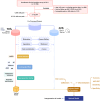Comparing interpretable machine learning models for fall risk in middle-aged and older adults with and without pain
- PMID: 40379780
- PMCID: PMC12084647
- DOI: 10.1038/s41598-025-01651-6
Comparing interpretable machine learning models for fall risk in middle-aged and older adults with and without pain
Abstract
Pain is common in middle-aged and older adults, has also been identified as a fall risk factor, whereas the mechanism of falls in pain is unclear. This study included 13,074 middle-aged and older adults from the China health and retirement longitudinal study (wave 2011-2015) to separately develop four-year fall risk prediction models for older adults with and without pain, using five machine learning algorithms with 145 input variables as candidate features. Shapley Additive exPlanations (SHAP) was used for the prediction model explanations. Adjusted logistic regression (LR) models showed that pain (OR 1.40 [1.29, 1.53]) was associated with a higher fall risk. Among pain characteristics, lower limb pain had the highest risk (OR 1.71 [1.22, 2.18]), followed by severe pain (OR 1.53 [1.36, 1.73]) and multisite pain (OR 1.43 [1.28, 1.55]). Among the fall prediction models for pain and non-pain, the LR model performed best with AUC-ROC values of 0.732 and 0.692, respectively. Common important features included fall history and height. Unique features for the pain model were functional limitation, SPPB, WBC, chronic disease score, life satisfaction, platelets, cooking fuel, and pain quantity, while marital status, age, depressive symptoms, cognitive function, hearing, rainy days, tidiness, and sleep duration were exclusive to the non-pain model. Pain characteristics are associated with falls among middle-aged and older adults. Prediction model can help identify people at high risk of falls with pain. Important features of falls differ between pain and non-pain populations, and prevention strategies should target specific populations for fall risk prediction.
Keywords: Falls; Machine learning; Older adults; Pain; Risk factors.
© 2025. The Author(s).
Conflict of interest statement
Declarations. Competing interests: The authors declare no competing interests.
Figures



Similar articles
-
Interpretable Machine Learning for Fall Prediction Among Older Adults in China.Am J Prev Med. 2023 Oct;65(4):579-586. doi: 10.1016/j.amepre.2023.04.006. Epub 2023 Apr 20. Am J Prev Med. 2023. PMID: 37087076
-
Urban-rural disparities in fall risk among older Chinese adults: insights from machine learning-based predictive models.Front Public Health. 2025 May 15;13:1597853. doi: 10.3389/fpubh.2025.1597853. eCollection 2025. Front Public Health. 2025. PMID: 40443937 Free PMC article.
-
Development and External Validation of a Machine Learning-based Fall Prediction Model for Nursing Home Residents: A Prospective Cohort Study.J Am Med Dir Assoc. 2024 Sep;25(9):105169. doi: 10.1016/j.jamda.2024.105169. Epub 2024 Jul 24. J Am Med Dir Assoc. 2024. PMID: 39067863
-
Deep Learning to Predict Falls in Older Adults Based on Daily-Life Trunk Accelerometry.Sensors (Basel). 2018 May 22;18(5):1654. doi: 10.3390/s18051654. Sensors (Basel). 2018. PMID: 29786659 Free PMC article. Review.
-
Population-based interventions for preventing falls and fall-related injuries in older people.Cochrane Database Syst Rev. 2024 Jan 5;1(1):CD013789. doi: 10.1002/14651858.CD013789.pub2. Cochrane Database Syst Rev. 2024. PMID: 38180112 Free PMC article.
References
-
- Who. Step Safely: Strategies for Preventing and Managing Falls across the life-course. Geneva: World Health Organization (2021).
-
- Who. Who Global Report on Falls Prevention in Older Age. Geneva: World Health Organization (2007).
-
- China disease prevention and control center. Technical guidelines for falls intervention in the elderly. http://www.nhc.gov.cn/cms-search/xxgk/getManuscriptXxgk.htm?id=52857
-
- Salis, F. et al. Sleep quality, daytime sleepiness, and risk of falling: results from an exploratory cross-sectional study. Eur. Geriatr. Med.16 (1), 197–204. 10.1007/s41999-024-01092-w (2025). - PubMed
Publication types
MeSH terms
Grants and funding
LinkOut - more resources
Full Text Sources
Medical

